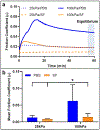Attachment of cartilage wear particles to the synovium negatively impacts friction properties
- PMID: 34399243
- PMCID: PMC8492547
- DOI: 10.1016/j.jbiomech.2021.110668
Attachment of cartilage wear particles to the synovium negatively impacts friction properties
Abstract
Cartilage wear particles are released into the synovial fluid by mechanical and chemical degradation of the articular surfaces during osteoarthritis and attach to the synovial membrane. Accumulation of wear particles could alter key tissue-level mechanical properties of the synovium, hindering its characteristically low-friction interactions with underlying articular surfaces in the synovial joint. The present study employs a custom loading device to further the characterization of native synovium friction properties, while investigating the hypothesis that attachment of cartilage wear particles increases friction coefficient. Juvenile bovine synovium demonstrated characteristically low friction coefficients in sliding contact with glass, in agreement with historical measurements. Friction coefficient increased with higher normal load in saline, while lubrication with native synovial fluid maintained low friction coefficients at higher loads. Cartilage wear particles generated from juvenile bovine cartilage attached directly to synovium explants in static culture, with incorporation onto the tissue denoted by cell migration onto the particle surface. In dilute synovial fluid mimicking the decreased lubricating properties during osteoarthritis, wear particle attachment significantly increased friction coefficient against glass, and native cartilage and synovium. In addition to providing a novel characterization of synovial joint tribology this work highlights a potential mechanism for cartilage wear particles to perpetuate the degradative environment of osteoarthritis by modulating tissue-level properties of the synovium that could impact macroscopic wear as well as mechanical stimuli transmitted to resident cells.
Keywords: Cartilage wear particles; Friction coefficient; Synovium; Tribology.
Copyright © 2021 Elsevier Ltd. All rights reserved.
Conflict of interest statement
Conflict of Interest Statement
The authors have no conflicts to disclose.
Figures




References
-
- Ateshian GA and Mow VC (2005). Lubrication and Wear of Diarthrodial Joints. Basic Orthopaedic Biomechanics and Mechanobiology. Mow VC and Huiskes R. Philadelphia, PA, Lippincott Williams & Wilkins.
-
- Ateshian GA, Soslowsky LJ and Mow VC (1991). "Quantitation of Articular Surface Topography and Cartilage Thickness in Knee Joints Using Stereophotogrammetry.".I. Biomechanics 24(8): 761–776. - PubMed
-
- Basalo IM, Chahine NO, Kaplun M, Chen FH, Hung CT and Ateshian GA (2007). "Chondroitin sulfate reduces the friction coefficient of articular cartilage." J Biomech 40(8): 1847–1854. - PubMed
Publication types
MeSH terms
Grants and funding
LinkOut - more resources
Full Text Sources

